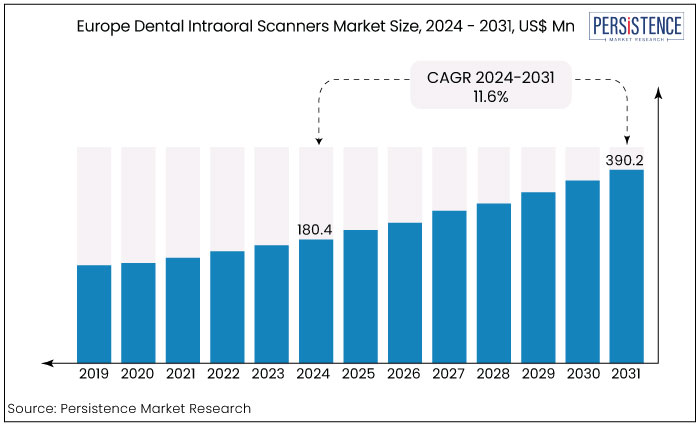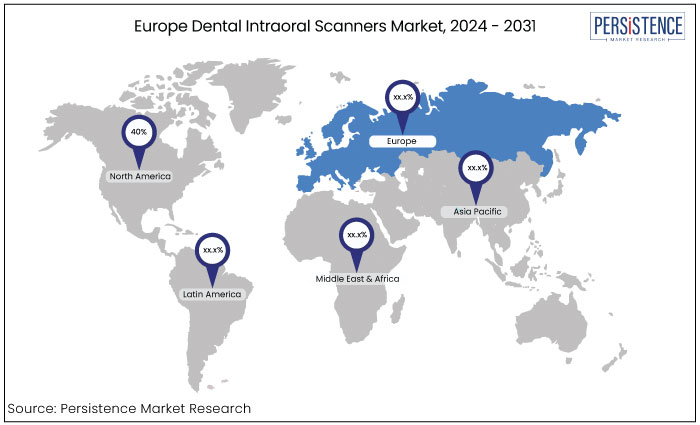Industry: Healthcare
Published Date: September-2024
Format: PPT*, PDF, EXCEL
Delivery Timelines: Contact Sales
Number of Pages: 177
Report ID: PMRREP34809
Europe dental intraoral scanners market is estimated to increase from US$180.4 Mn in 2024 to US$390.2 Mn by 2031. The market is projected to record a CAGR of 11.6% during the forecast period from 2024 to 2031. The rise of dental tourism in Eastern and Southern Europe is driving demand for high-quality, cost-effective intraoral scanning solutions. Germany is predicted to be the dominating country in Europe.

Key Highlights of the Market
|
Market Attributes |
Key Insights |
|
Europe Dental Intraoral Scanners Market Size (2024E) |
US$180.4 Mn |
|
Projected Market Value (2031F) |
US$390.2 Mn |
|
Global Market Growth Rate (CAGR 2024 to 2031) |
11.6% |
|
Historical Market Growth Rate (CAGR 2019 to 2023) |
10% |
Germany boasts one of the most developed healthcare systems in Europe, with widespread adoption of cutting-edge dental technologies in clinics and hospitals. This strong infrastructure supports the integration of intraoral scanners.
The country has a growing population with a high awareness of oral health fueling demand for advanced dental treatments, including digital impressions through IOS. Germany's aging population further drives the need for restorative and cosmetic dental care.
German manufacturers are renowned for precision engineering and technological advancements. Local companies such as Dentsply Sirona are at the forefront of dental innovation, providing cutting-edge intraoral scanners to meet market needs.

|
Category |
Market Share in 2024 |
|
Technology - Confocal Microscopic Imaging |
42% |
Based on technology, the market is divided into confocal microscopic imaging and optical ward. Among these, the confocal microscopic imaging technology dominates the market. Confocal microscopic imaging holds the largest market share of 42%.
Confocal microscopic imaging is employed in intraoral scanners to generate intricate three-dimensional representations of oral anatomy. It employs a laser or alternative light source to illuminate the target area and a confocal pinhole to eliminate out-of-focus light. This advanced imaging technology facilitates the creation of high-resolution digital impressions.
Applying confocal microscopic imaging technology in intraoral scanners enhances the quality and precision of digital impressions. It enables practitioners to capture intricate features of dental anatomy, improving the accuracy of restorations, orthodontic planning, and various dental operations.
|
Category |
Market Share in 2024 |
|
End Use - Dental Hospitals & Clinics |
55% |
Based on end use, the market is segmented into dental hospitals & clinics, dental diagnostic centres, and research institutes, where the dental hospitals and clinics segment dominates the market.
Dental hospitals and clinics constitute the primary end-users of the industry. Dental hospitals and clinics are the primary consumers of intraoral scanners. These facilities employ intraoral scanners for diverse diagnostic, treatment planning, and therapeutic applications.
Intraoral scanners enable dental practices to manage many scenarios, enhancing the efficiency and accuracy of dental workflows.
In dental hospitals and clinics, intraoral scanners are essential for comprehensive dental care. From routine examinations to advanced restorative and orthodontic interventions, these devices facilitate precise digital impressions, assist in treatment planning, and enhance patient experiences.
Dental intraoral scanners capture intricate, three-dimensional images of intraoral structures, including teeth and adjacent tissues. These scanners have become indispensable tools in contemporary dentistry practices revolutionizing the process of obtaining dental impressions.
Intraoral scanners have gained significant popularity in general dental practices globally owing to their user-friendliness for patients. The increasing prevalence of dental problems and an elderly demographic experiencing tooth loss have driven the demand for intraoral scanners in dental hospitals and clinics.
The elevated expense of equipment has constrained the expansion of the dental intraoral scanners market. Numerous prominent companies are implementing measures to enhance their market sales.
Periodontal diseases refer to illnesses affecting the gums and the supporting bone structure of teeth. Awareness of these disorders is increasing as various public and private entities collectively highlight their difficulties in dental and oral health. The United Nations and the World Health Organization (WHO) have partnered to develop a strategy to increase awareness of these diseases among low-income populations.
Europe intraoral scanners market has seen steady growth pre-2023 driven by the increasing adoption of digital dentistry across the region. The growth fueled by the shift toward digital solutions in dental practices, the need for precise dental impressions, and the rising demand for minimally invasive procedures.
Leading dental clinics and laboratories across Europe adopted intraoral scanners to streamline workflows and improve patient outcomes leading to enhanced accuracy and reduced treatment times.
Europe dental intraoral scanners market is projected to experience accelerated growth, which is said to be driven by ongoing technological advancements in scanner systems, and increasing integration with CAD/CAM platforms.
Supportive regulatory frameworks and increased investment in healthcare infrastructure will further propel the market. The growing demand for aesthetic dentistry and the increasing penetration of digital tools in small and mid-sized dental clinics across Europe is projected to expand market opportunities post-2024 making it one of the most promising sectors in the dental industry.
Shift Toward Digital Dentistry and Efficiency in Workflow
One of the key growth drivers for the Europe dental intraoral scanners market is the increasing shift toward digital dentistry. Dental practices and laboratories are significantly adopting digital technologies like intraoral scanners to enhance workflow efficiency and accuracy.
Unlike traditional impression-taking methods, which are time-consuming and prone to errors, intraoral scanners provide immediate and precise digital impressions reducing patient chair time and improving treatment outcomes.
The shift also facilitates better collaboration between dentists and dental labs through seamless digital file sharing further streamlining the restoration process. The demand for digital dentistry is especially high in Europe due to the region’s advanced healthcare infrastructure and the growing need for minimally invasive and patient-friendly dental procedures.
Technological Advancements in Intraoral Scanners
Technological advancements are significantly driving the adoption of intraoral scanners in Europe. Modern scanners are accurate, fast, and user-friendly than earlier versions allowing for a smooth transition from traditional to digital impressions.
Features like enhanced imaging accuracy, real-time 3D modelling, and integration with CAD/CAM systems make these scanners indispensable tools in modern dental practices. In particular, the development of wireless, portable scanners have made it easy for clinics to adopt this technology.
The integration of artificial intelligence (AI) in scanners enhances diagnostic capabilities, enabling dentists to identify potential dental issues during the scanning process. These innovations have significantly boosted the market and will continue to drive growth post-2024.
Rising Demand for Aesthetic and Minimally Invasive Dentistry
There is an increasing demand for aesthetic dentistry in Europe as patients seek treatments that restore dental functionality and enhance appearance. Intraoral scanners play a crucial role in this trend by providing highly accurate digital impressions, which are essential for the creation of aesthetic restorations such as crowns, bridges, and veneers.
The scanners enable dentists to deliver better-fitting, natural-looking restorations, which are highly sought after in cosmetic dental procedures. Intraoral scanners support minimally invasive dental practices by eliminating the need for traditional, uncomfortable impression materials thus enhancing the patient experience.
As awareness of aesthetic dental solutions grows across Europe, so will the demand for intraoral scanners particularly in countries with strong healthcare systems like Germany, France, and the United Kingdom.
High Initial Costs of Intraoral Scanners
A key restraint for the Europe dental intraoral scanners market is the high initial cost of purchasing and implementing these devices. Intraoral scanners are a significant investment for dental practices, with prices often ranging from €15,000 to €40,000 per unit, depending on the model and features. This upfront cost can be a significant barrier for smaller practices and clinics with limited budgets especially when combined with additional expenses for training, software upgrades, and maintenance.
While large clinics and hospitals can absorb these costs, small dental practices may hesitate to adopt the technology slowing market growth in some regions. This issue is particularly pronounced in countries where dental insurance reimbursement policies do not cover digital dental technologies making it hard for practitioners to justify the investment.
Integration with Artificial Intelligence (AI) and Machine Learning (ML)
One of the most transformative opportunities in the Europe dental intraoral scanners market is the integration of AI and machine learning technologies. AI-powered intraoral scanners can analyze dental scans in real time, offering enhanced diagnostic capabilities and aiding in treatment planning. These systems can detect early signs of dental issues such as cavities, misalignments, and gum disease with higher precision than traditional methods.
By improving accuracy, AI not only helps in better treatment outcomes but also reduces the need for multiple scans or adjustments, thus saving time and costs for both dentists and patients. The growing incorporation of AI in dental practices will significantly enhance clinical workflows and attract more practices to adopt intraoral scanning technologies.
Rise of Dental Tourism in Eastern and Southern Europe
The rise of dental tourism in countries like Hungary, Poland, and Turkey offers a transformative opportunity for the Europe dental intraoral scanners market. These regions are becoming popular destinations for patients from Western Europe, where dental treatments are more expensive.
Intraoral scanners, with their ability to provide quick, accurate, and high-quality digital impressions can enhance the efficiency of dental tourism services ensuring that patients receive top-quality care in a shorter time frame. Dental clinics in these regions can further attract international patients by offering advanced digital dental services at competitive prices boosting both the local economy and the adoption of intraoral scanners.
Europe dental intraoral scanners market is characterized by a competitive landscape with several prominent players driving innovation and growth. Other notable players include Planmeca, with its Planmeca Emerald, and Carestream Dental, offering the CS 3600 scanner.
Leading companies focus on technological advancements such as higher resolution imaging, faster scanning speeds, and integration with digital workflows to differentiate themselves. Strategic initiatives like mergers, acquisitions, and partnerships are common as companies aim to expand their market share and technological capabilities.
Increasing investment in research and development, as well as expansion into emerging markets, further intensifies competition in the region.
Recent Industry Developments in the Europe Dental Intraoral Scanners Market
|
Attributes |
Details |
|
Forecast Period |
2024 to 2031 |
|
Historical Data Available for |
2019 to 2023 |
|
Market Analysis |
US$ Billion for Value |
|
Key Countries Covered |
|
|
Key Segments Covered |
|
|
Key Companies Profiled in the Report |
|
|
Report Coverage |
|
|
Customization & Pricing |
Available upon request |
By Type
By Technology
By End Use
By Country
To know more about delivery timeline for this report Contact Sales

The market growth is driven by the technological advancements in intraoral scanners.
The market is projected to record a CAGR of 11.6%
Germany holds the largest market share in Europe market.
Some of the top key players in the market are Dentsply Sirona Inc, Institut Straumann AG, and Align Technology Inc.
A prominent opportunity lies in the Integration with artificial intelligence (AI) and machine learning (ML).